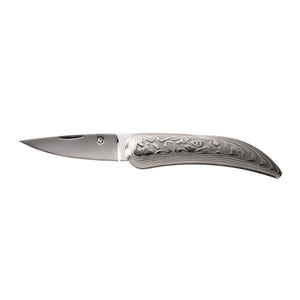Unveiling the Japanese Folding Knife
Apr 03, 2024
In the world of personal tools for men, few objects encapsulate the essence of craftsmanship quite like a folding knife. With its seamless combination of artistry and functionality, it has captivated enthusiasts and professionals alike, earning a well-deserved reputation for its unrivaled beauty and unparalleled cutting performance.
Be it German, Japanese or Swiss, men seem to love these objects. And for a good reason! They represent a sense of freedom and quick action that we deeply love. We want to have a handy solution that ideally impresses people around us.
The Japanese folding knife
Japanese knives are the best not just because of the premium material used to make them, but also because of the meticulous attention to detail during the forging process. These knives embody the spirit of the Japanese tradition and the spirit of the craftsman who makes them. Passed down through generations, the skills used in their production make each knife a unique piece.
The allure of the Japanese folding knife lies not only in its exquisite craftsmanship but also in its exceptional cutting capabilities. The precision and sharpness of these blades make them indispensable tools for chefs, and anyone in need of reliable cutting power.
Today we delve into the world of the Japanese folding knife, exploring its history, craftsmanship, and why these blades continue to hold a special place in the hearts of blade enthusiasts around the globe. Discover the artistry, tradition, and allure that make the Japanese folding knife an object of desire for collectors and users alike. And finally, we take a look at Suwada's Damascus Steel folding knife, featuring a Damascus handle and a polished blade.
This knife even won a GDS (Design award).

History and significance of craftsmanship in Japan
Craftsmanship holds a significant place in Japanese culture and history. The Japanese have long been known for their dedication to perfection and attention to detail in every aspect of their craftsmanship, whether it be in ceramics, woodworking, or blade-making. This commitment to excellence can be traced back to ancient times when the art of craftsmanship was considered a sacred and spiritual practice.
Japan's feudal period, from the 12th to the 19th century, witnessed the rise of the samurai class, who became the prominent patrons of swordsmiths. The katana became a symbol of power and social status. The process of forging a katana is a meticulous and sometimes a spiritual endeavor. It involves the blending of different metals, shaping the blade, and finally, the long process of polishing. The art of sword-making was passed down from master to apprentice, with each generation striving to improve upon the mastery of their masters.
Tsubame-Sanjo, where Suwada's HQ are located traces its blacksmithing origin to the 16th century. Master blacksmiths from Edo (Tokyo) moved there to teach the locals how to make hammers and nails so that they can easily create their own dams and bridges, as the area was often flooding. Suwada pays tribute to this legacy by various objects. One of them is the Damascus handle folding knife.
The art of Japanese knife-making
The techniques used in crafting these knives have been refined over time. The resulting blades are exceptional in terms of quality and precision. Japanese blades are renowned for their sharpness, durability, and ability to retain their edge. Blades from Tsubame-Sanjo are particularly famous for that as the craftspeople really focus on the longevity of a knife as well as its sharpness, as opposed to other knives made just to be sharp, but remain brittle.
One of the key aspects of Japanese knife-making is the choice of materials. The blades are typically made from high-carbon steel, known for its superior hardness and edge retention. The steel is carefully selected and forged using traditional methods. This process not only strengthens the blade but may also include steps that give it a distinctive pattern.
The handle of a Japanese folding knife, also known as the hilt or tsuka, is traditionally made from materials such as wood, bone, or horn. Suwada's Damascus steel handle is heavy and very laborious to make. These materials are chosen for their durability, comfort, and aesthetic appeal.
The appeal of folding knives
A folding knife is an accessory. The blades are small, and you can use them to cut anything from a piece of rope to a lemon zest. Suwada aims to create a gentleman's tool with this knife. The feedback we received has been incredible and our customers appreciate the timeless appeal and the visible craftsmanship of the textured handle. We are deeply thankful, and we hope you enjoyed this short article! Let us know if you already have a Suwada folding knife! We always love to read your emails!
As always, have a fantastic day.


